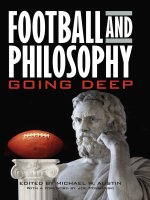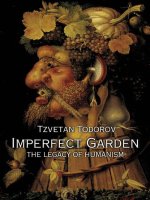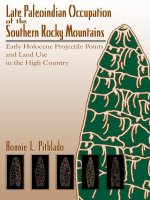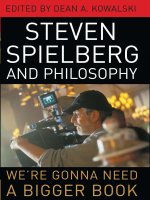university press of florida the archaeology of traditions agency and history before and after columbus sep 2001
Bạn đang xem bản rút gọn của tài liệu. Xem và tải ngay bản đầy đủ của tài liệu tại đây (2.39 MB, 369 trang )
S
T
A
T
E
U
N
I
V
E
R
S
I
T
Y
S
Y
S
T
E
M
U
N
I
V
E
R
S
I
T
Y
P
R
E
S
S
O
F
F
L
O
R
I
D
A
UWF
FSU
FAMU
UNF
UF
UCF
USF
FGCU
FAU
FIU
Florida A&M University, Tallahassee
Florida Atlantic University, Boca Raton
Florida Gulf Coast University, Ft. Myers
Florida International University, Miami
Florida State University, Tallahassee
University of Central Florida, Orlando
University of Florida, Gainesville
University of North Florida, Jacksonville
University of South Florida, Tampa
University of West Florida, Pensacola
The Archaeology of Traditions
The Ripley P. Bullen Series
Florida Museum of Natural History
This page intentionally left blank
The Archaeology of Traditions
Agency and History Before and After Columbus
Edited by Timothy R. Pauketat
Foreword by Jerald T. Milanich, Series Editor
University Press of Florida
Gainesville · Tallahassee · Tampa · Boca Raton
Pensacola · Orlando · Miami · Jacksonville · Ft. Myers
Copyright 2001 by Timothy R. Pauketat
Printed in the United States of America on acid-free paper
All rights reserved
06 05 04 03 02 01 6 5 4 3 2 1
Library of Congress Cataloging-in-Publication Data
The archaeology of traditions: agency and history before and after Colum-
bus / edited by Timothy R. Pauketat; foreword by Jerald T. Milanich.
p. cm. — (The Ripley P. Bullen series)
Includes bibliographical references and index.
ISBN 0-8130-2112-X (alk. paper)
1. Indians of North America—Southern States—Antiquities. 2. Social ar-
chaeology—Southern States. 3. Southern States—Antiquities. I. Pauketat,
Timothy R. II. Series
E78.S65 A79 2001
975'.01—dc21 00-066785
The University Press of Florida is the scholarly publishing agency for the
State University System of Florida, comprising Florida A&M University,
Florida Atlantic University, Florida Gulf Coast University, Florida Interna-
tional University, Florida State University, University of Central Florida,
University of Florida, University of North Florida, University of South Flor-
ida, and University of West Florida.
University Press of Florida
15 Northwest 15th Street
Gainesville, FL 32611–2079
Disclaimer:
Some images in the original version of this book are not
available for inclusion in the eBook.
Dedicated to an earlier generation of hard-working archaeologists
who dug up history, tradition, and ethnicity, and who enjoyed the
hell out of it.
This page intentionally left blank
Contents
List of Figures ix
List of Tables x
Foreword xi
Preface xiii
1. A New Tradition in Archaeology, by Timothy R. Pauketat 1
2. African-American Tradition and Community in
the Antebellum South, by Brian W. Thomas 17
3. Resistance and Accommodation in Apalachee Province,
by John F. Scarry 34
4. Manipulating Bodies and Emerging Traditions at
the Los Adaes Presidio, by Diana DiPaolo Loren 58
5. Negotiated Tradition? Native American Pottery in the Mission
Period in La Florida, by Rebecca Saunders 77
6. Creek and Pre-Creek Revisited, by Cameron B. Wesson 94
7. Gender, Tradition, and the Negotiation of Power Relationships
in Southern Appalachian Chiefdoms, by Lynne P. Sullivan and
Christopher B. Rodning 107
8. Historical Science or Silence? Toward a Historical Anthropology
of Mississippian Political Culture, by Mark A. Rees 121
9. Cahokian Change and the Authority of Tradition, by Susan
M. Alt 141
10. The Historical-Processual Development of Late Woodland
Societies, by Michael S. Nassaney 157
11. A Tradition of Discontinuity: American Bottom Early and Middle
Woodland Culture History Reexamined, by Andrew C. Fortier 174
12. Interpreting Discontinuity and Historical Process in Midcontinental
Late Archaic and Early Woodland Societies, by Thomas E.
Emerson and Dale L. McElrath 195
13. Hunter-Gatherers and Traditions of Resistance, by Kenneth E.
Sassaman 218
14. Traditions as Cultural Production: Implications for Contemporary
Archaeological Research, by Kent G. Lightfoot 237
15. Concluding Thoughts on Tradition, History, and Archaeology,
by Timothy R. Pauketat 253
Bibliography 257
List of Contributors 337
Index 343
Figures
1.1. Locator map 2
1.2. Pre-Columbian pottery bottle from Arkansas 7
1.3. Wall-trench building floor, ca. a.d. 1100, southwestern Illinois 9
1.4. Plains Indian pow-wow dance ground 11
1.5. Positions taken by volume authors along the tradition-building
continuum 14
2.1. Purse clasp found at slave cabin site at the Hermitage 22
2.2. Gold 1853 U.S. dollar recovered at slave cabin site 23
2.3. Map of the Hermitage Plantation showing slave housing areas 31
4.1. De Español y Morisca, Albino, ca. 1760–1770 65
4.2. De Indio y Mestiza, Coyote, ca. 1760–1770 65
5.1. Location of Native American groups and missions, ca. 1660 80
5.2. Design motifs 83
7.1. Selected archaeological sites in the greater southern Appalachians
113
7.2. Archaeological map, Overhill Cherokee settlement, a.d.
1700–1800 116
7.3. Archaeological map, Coweeta Creek site, a.d. 1600–1700 117
8.1. Winged-serpent motif on a Moundville engraved bottle 135
8.2. Fish effigy vessel from the Campbell site 137
9.1. Select sites within the greater Cahokia region 142
9.2. Upland Mississippian site plans 147
9.3. Comparison of structure type and size 148
9.4. Selected vessel type mean-diameter sizes 152
10.1. Distribution of Baytown–Coles Creek Period sites by type 165
10.2. Rank-size relation of Baytown–Coles Creek period sites 167
11.1. Revised time scale for the Early and Late Woodland periods of the
American Bottom 179
11.2. Early Woodland ceramic traditions 181
11.3. Middle Woodland bifacial chert tool assemblage 184
11.4. Middle Woodland blade tool tradition 185
11.5. Middle Woodland ceramic design formats 191
Tables
2.1. Marriages by occupation at the Hermitage, 1829–1855 30
4.1. Dress artifacts from Los Adaes houses 69
4.2. Ceramics from Los Adaes houses 71
4.3. Trade goods from Los Adaes houses 71
4.4. Faunal remains from Los Adaes structures 73
11.1. Hallmarks of American Bottom Middle Woodland assemblages 188
Foreword
Archaeologists long have divided themselves into two camps, historical
archaeologists and nonhistorical archaeologists, those who studied pre-
Columbian cultures. As Timothy R. Pauketat of the University of Illinois
notes, historical archaeologists, blessed with written records as a source of
data, had the luxury of examining documents to help them document
historical processes and determine “what regularities owe their origins to
common historical linkages.” On the other hand, archaeologists studying
the pre-Columbian past searched for those common processes that ex-
plain “all people in all places.”
In recent years the theoretical schism between historical and “pre-
historical” archaeologists has begun to blur as a new paradigm dubbed
“historical processualism” has emerged, one which recognizes that we can
better understand the past in terms of history, defined here as “cultural
construction through practice.” What people and groups did in the past is
best understood within the context of their histories and cultures, within
their traditions. History defined in this fashion is not the purview solely of
historians or of historical archaeologists, and the archaeology of historical
process becomes an important guide to explaining the past.
In his introductory chapter, Pauketat offers a cogent discussion of this
theoretical approach, which is then amplified and demonstrated in twelve
case studies, each penned by an archaeological scholar working in the
southeastern United States.
Kent Lightfoot supplies a commentary that assesses how well the
volume’s individual authors accomplished their task, focusing in part on
their multiple uses and multiscalar approaches to cultural/historical tradi-
tions. He also examines the concepts of traditions and historical processes
beyond the Southeast.
Archaeology continues to evolve as a discipline, refining new theoreti-
cal approaches that help us to model the past in novel ways. These are
exciting times that are providing fresh tools for understanding all of hu-
man history and the dynamics that have made the world what it is today.
The Archaeology of Traditions: Agency and History Before and After
xii | Foreword
Columbus is at the forefront of applying this paradigm shift to archaeo-
logical data sets. I am pleased that the University Press of Florida and the
Ripley P. Bullen Series can share in what is certainly an important chal-
lenge for the discipline of archaeology.
Jerald T. Milanich
Series Editor
Foreword | xiii
Preface
This book spotlights a part of the world, southeastern North America, as
a means to an end. That end can be summed up as the search for how
history happened, a search with considerable relevance beyond the South-
east. Figuring out how change in human identities and relations happened,
more than why change may have happened, is the guts of American ar-
chaeology at the beginning of the twenty-first century. In point of fact, I
am not altogether certain that why questions can be resolved without
bringing a truckload of metaphysical baggage to the table.
In archaeology, answers to such why questions have tended to do little
more than reify their initial assumptions about how human beings “be-
have.” How, in that case, is an unchanging quality of humanity that why-
researchers believe to be true. It is not the subject of investigation, and that
is a mistake. Permit me a brief digression to explain what I mean. Someone
at a Southeastern Archaeological Conference recently asked me why
people built pyramids of earth, stone, or mud brick around the world
throughout history. My response went something like this: perhaps there
is some innate human tendency to build toward the sky, but that’s a ques-
tion of human nature, not human culture. It is a question for a psycholo-
gist, a biologist, perhaps a theologian, but not an archaeologist. What do
we learn from this answer that we didn’t already accept or reject in the
beginning? Not much.
It is more satisfying to compare how cultural phenomena happened at
various points in time and across space. That is what this book is all about.
The Southeast is well suited to the investigation of what we label “histori-
cal processes” and exemplifies a direction in which archaeology in general
must move. Perhaps, if we try to figure out how history happened, we may
one day be able to answer the ultimate metaphysical questions of our day
(emphasis on “our day”). However, this will come only after dealing with
the proximate how questions that archaeology has asked too infrequently
and too timidly. Moreover, the relevance of those why questions may have
faded before we get a chance to answer them.
xiv | Preface
This volume is an outgrowth of a symposium titled “Resistant Tradi-
tions and Historical Processes in Southeastern North America” at the 64th
Annual Meeting of the Society for American Archaeology in Chicago,
March 1999. I would like to thank the original participants of that ses-
sion, all of whom are represented in the present volume except for
Kathleen Deagan, who served as a discussant alongside Kent Lightfoot.
The original idea for the session was the study of resistance before and
after Columbus. However, that theme began to drift almost immediately
toward a broader focus on tradition and tradition making. In this regard,
the Southeast and all things traditional go together remarkably well. Ar-
chaeologists in the Southeast are fortunate to have a wealth of data that
speaks directly to issues of an archaeology of traditions, and for this many
individuals, private foundations, and public organizations are owed debts
of gratitude. Of those directly supportive of my own research (spilt into
this volume just a little), I would like to thank the National Science Foun-
dation, the National Geographic Society, the Wenner-Gren Foundation
for Anthropological Research, the University of Illinois, the Illinois De-
partment of Transportation, the Illinois Transportation Archaeological
Research Program, and Cahokia Mounds Museum Society.
1
A New Tradition in Archaeology
Timothy R. Pauketat
People have always had traditions, practiced traditions, resisted tradi-
tions, or created traditions. Archaeologists cannot avoid dealing with the
concept. Broken potsherds, stone tools, and the remains of houses, farms,
and fields virtually scream “tradition!” But this seemingly simple concept
is not as straightforward as one might assume. Power, plurality, and hu-
man agency are all a part of how traditions come about. Traditions do not
simply exist without people and their struggles involved every step of the
way. This book reexamines that human involvement by analyzing a series
of historically divergent and yet interrelated traditions from one macro-
regional “tradition”: the American Southeast (see fig. 1.1).
In everyday parlance, “tradition” means something learned from the
past, something persistent or unchanging, or something old-fashioned. As
commonly understood, traditions impede change by constraining what
can be done by the people living with them. Believing this, an earlier gen-
eration of archaeologists isolated different traditions and attempted to
explain why they were where they were (see Caldwell 1958; Haury 1956;
Willey and Phillips 1958). A later generation of “processual” archaeolo-
gists adopted a more utilitarian view; traditions, as learned ways of doing
or making things, allowed a group to survive (see Binford 1965).
The earlier generation’s theories of cultural change and those of the
processual archaeologists, not to mention time-honored methods of se-
quencing cultural remains, rest on taken-for-granted notions of tradition
(cf. Marquardt 1978). Sometimes stated, but often unstated, they adhere
to a deeply engrained view that ideas, cultures, or styles change gradually
and slowly while political and economic spheres change rapidly. For them,
traditions are conservative and cultures are seen to lag behind the times,
retaining vestiges of earlier periods. This adherence, which cannot be as-
signed to a specific school of thought, is increasingly called into question
2 | Timothy R. Pauketat
by more recent studies that place people back into anthropological models
of how change comes about (see Rees, this volume).
Today, tradition and related concepts are reappearing in discussions
that purport to redirect how we explain the past (Dobres 2000; Hendon
1996; Joyce and Hendon 2000; Lightfoot et al. 1998; Pauketat 2001).
From a contemporary perspective, a tradition is some practice brought
from the past into the present. It may be a personal practice, a group
practice, or an entire population’s practice. By opening up the definition
thus, I do not intend to make it so general as to lack explanatory utility.
Technically, certain traditions at the personal or population ends of the
spectrum may not be useful abstractions. However, opening up the defini-
tion allows one to argue that traditions are not passive and benign ways of
G
u
l
f
o
f
M
e
x
i
c
o
Atlantic Ocean
selected sites
mentioned in text
study areas by AUTHOR
KEY
0
300
miles
THOMAS
Charleston
SAUNDERS
ALT
King
Los Adaes
FORTIER
Irene
St. Augustine
SASSAMAN
EMERSON
and
McELRATH
Cahokia
NASSANEY
The
Hermitage
Toqua
WESSON
Moundville
Nodena
Toltec
LOREN
REES
SCARRY
San Luis
SULLIVAN and RODNING
Fig. 1.1. Locator map.
A New Tradition in Archaeology | 3
doing things but are malleable, subject to politicization, and always “ne-
gotiated” between persons and among peoples at multiple scales. Tradi-
tion in this sense is part of the dynamic and contingent “cultural construc-
tion” process, a fluid “reactualization” of the past (see Borofsky 1987;
Hobsbawn and Ranger 1983; Sahlins 1985; Toren 1999; see also Coma-
roff and Comaroff 1991). Given this broadened sense of tradition, archae-
ologists should be able to address a central question of the human experi-
ence. How do people throughout history become separate peoples with
seemingly distinct identities, ways of doing and thinking, and specific
technologies to cope with the outside world?
David Kertzer (1988) offers a series of examples that reveal traditions
(or traditional symbols) to be potent media for negotiations that generate
cultural change. For instance, fundamentalist religious leaders and politi-
cians use traditions to attract followers. Traditions used in such ways are
the basis of social movements, coalitions, or revolutions. These are cases
of tradition in the service of high-order political interests. In the course of
world history, such coopted traditions have built cathedrals and pyramids,
overthrown governments, and revitalized religions.
Other, lower-order traditions are also open to negotiation and change.
Stephen Shennan (1993) argues that representations or practices that are
beyond conscious reflection or without well-established cultural mean-
ings do, in fact, embody traditions. That is, the meanings of practices (if
any are even identifiable) may not be entirely clear to people who nonethe-
less actively reproduce them. People may not know why they dance or sing
or cook the way that they do, but they may do so because of habits that
seem consistent with the past (see Hendon 1996). “We do not believe our
religion,” says one Plains Indian informant, “we dance it!” (J. E. Brown
1977:123). The question remains: How susceptible might such embodied
traditions be to change?
Traditions, that is, present us with a conundrum. Do they thwart or
promote change? If the latter, then when does a tradition cease to be tra-
ditional? Can cultural change even occur outside of traditional practices?
This puzzle indicates the need for better concepts to deal with the process
of tradition making. A series of such concepts are used throughout this
volume, including practice, doxa, ethnogenesis, community, resistance,
and official and unofficial traditions. With the aid of these, the resolution
to the conundrum will be found in the revised understanding of southeast-
ern history and the fundamental “materiality” of southeastern traditions.
I begin in this introduction by focusing on two facets of the process of
tradition making: constraints and practice.
4 | Timothy R. Pauketat
History as Tradition Making
History and tradition are closely intertwined. In fact, I define history as
the process of tradition building or as “cultural construction through
practice” (Pauketat 2001). Before I elaborate, let me note what history is
not. First, history is not merely the background noise, window-dressing,
or irrelevant details of social or cultural evolution (cf. Bamforth and
Spaulding 1982). Second, history is not “narrative,” and archaeological
remains are not “texts” to be read in different ways depending on one’s
contemporary biases (see Hodder 1989).
A dismissal of history as mere detail was common to the processual
archaeology of the 1970s and derives from an often unstated commitment
to the insidious notion of behavior (see Pauketat 2001). As used in archae-
ology, behavior has implied a uniformity of action that allows a popula-
tion to cope with some condition. This is insidious because it means that
actual people and their traditions have little explanatory value.
The history-as-narrative argument is a “postmodern” position, taken
most often by nonarchaeologists, that locates history in the present-day
interpretive narratives of some person or group instead of in the past (e.g.,
Errington 1998). The argument goes: there are many narratives about the
past, and who are we to claim that archaeology can deduce the truth from
among them (see Shanks and Tilley 1987)?
1
Fortunately, we may dispense
with this history-as-narrative position. Narratives do exist, but only as
part of any process of tradition building. They are acts of interpretation
with reference to the past, not the entirety of actions—not the diachronic
series of actions—that gave shape to the present or to any moment in time.
One might think of history as a whole series of interconnected narratives,
the point being that how those narratives were constructed relative to each
other is something concrete and very different from a single narrative.
Archaeologists can measure such concrete, diachronic series using the resi-
dues of what people actually did. Narratives can lie; people’s garbage
seldom does (see Rathje 1974).
My definition of history as the process of tradition building or cultural
construction through practice is considerably broader than history as ei-
ther noise or narrative. History is the practicing and embodying of tradi-
tions on a daily basis. “Practice” in the sense that I use it refers to any
enactment, embodiment, or representation of one’s dispositions (see Ar-
cher 1996; Bell 1997; Bourdieu 1977, 1990; de Certeau 1984; Giddens
1979, 1984; Ortner 1984; Sahlins 1985). One is disposed to do and to be
in certain ways because of one’s experiences in social settings. The doing
A New Tradition in Archaeology | 5
and being is practice, not behavior, because doing and being are contin-
gent on historical context.
Constraints
At various times and places, what people did, how they identified them-
selves, and who they became was constrained in different ways by those
times and those places. Individuals were not free to act as completely
rational decision makers although, within preexisting parameters, they
would have thought and acted in ways that continuously altered those
parameters. Meanings, environments, identities, regional cultures, or
other traditions all could be called constraints.
2
Southeastern North
America, for instance, has been characterized as a cultural and an environ-
mental constraint; it involved distinctive biomes, panregional cultural
patterns, and creolized “southern” traditions. Such constraints, so very
large in scale, may seem beyond the realm of direct change through daily
practices. Environmental change, for instance, might seem to stand apart
from social change, if not to be a cause of it (see Anderson et al. 1995).
Likewise, the myths and cosmological themes of the pre-Columbian
Southeast—the quartered circle, the bi-lobed arrow, or the earth mother—
may appear as unchanging structures that constrained cultural practices
(see R. L. Hall 1997).
This view of constraints, while not altogether wrong, is deceptive. The
principal problem with the concept of constraint is the extent to which it
allows us to think of the process of cultural construction as a series of
transformations between constraints, as if the latter were static states that
stood apart from the process of tradition building itself (for a parallel
argument, see Plog 1973). With specific regard to the use of tradition as
constraint, archaeologists mistakenly assume the existence of widely
shared, unchanging, and homogeneous cultures. Hence, they do not view
traditions as requiring explanations. However, from the dynamic-tradi-
tion position advocated here, cultural heterogeneity is the rule rather than
the exception. Consequently, continuity demands an explanation.
By taking a dynamic-tradition position, one need not disavow descrip-
tive units of cultural-historical or sociological reconstruction that connote
homogeneity and continuity. We can still isolate and name traditions,
meanings, environments, identities, regional cultures, and the like. Indeed,
recognizing and naming macroscale patterns are first steps toward
processual explanations. These patterns are real and, depending on how
they are recognized, may have considerable interpretative utility. For in-
6 | Timothy R. Pauketat
stance, an archaeological ceramic tradition or a chronological phase may
correlate with some past social upheaval, demographic shift, popular
movement, residential unit, or labor coordination (see Alt, Emerson and
McElrath, Fortier, Sassaman, Saunders, this volume). In my own research,
phases established thirty years ago based on pottery styles seem to corre-
late relatively well with new information on major developments in the
formation and disintegration of a pre-Columbian polity (Pauketat
1998b). This is perhaps not surprising to many archaeologists who retain
an implicit faith in their ability to account for the past. Given the present
views of practice and materiality, it is even less surprising.
Nonetheless, we must remain cognizant of the fact that the recognized
cultural patterns—traditions, meanings, identities, environments, phases,
and so on—are only imperfect abstractions of past cultural processes.
Even seemingly ancient myths, icons, or cosmological themes are not truly
static (see Nöth 1990 and Turner 1967 for common uses of these con-
cepts). The “deep” thematic qualities that lend an appearance of cultural
persistence also made the myths, icons, or cosmological themes especially
effective political symbols to be displayed, manipulated, and co-opted by
social movements or astute politicians (see Cohen 1974; Kertzer 1988).
Consider the varied uses and emotional evocations of the Christian cross,
the Confederate flag, the color red, or the southeastern cross-in-circle
motif (Emerson 1999:271). The basic and seemingly uniform meanings of
these symbols continue to be manipulated; referents are reconfigured;
values and associations are altered (see Barth 1987). For instance, a pre-
Columbian pot featuring cross-in-circle symbolism would not have meant
quite the same thing as the same symbol in another medium or another
context, owing to the novel referents and associations of the pot’s con-
tents, the time or place of the pot’s use, or the people who made, used, or
possessed the pot (Pauketat and Emerson 1991; and see fig. 1.2).
Note that I am not saying that things, such as the pot or the pot’s
symbolism, are subject to negotiation. Rather, I am saying that the very
idea of “thingness” is problematic. The pot and its symbolism are them-
selves negotiations. As put into practice, they are the process of cultural
construction. This realization, in fact, constitutes the first step in the aban-
donment of materialist explanations in archaeology. Once these are aban-
doned, archaeology will have to seriously modify an array of commonly
accepted processual generalizations in which antecedent conditions—
strategies, population levels, ideologies, political systems, or various sorts
of traditions—are treated as if they possessed causal power to produce
A New Tradition in Archaeology | 7
some effect apart from people. It is true that materialist arguments in
archaeology have produced significant advances in our general knowledge
about the relationships between constraints. For example, insightful cor-
relations have been made between group size and hierarchy, political insti-
tutions and ideologies, domestication and sedentism, and artifact distribu-
tions, ethnicities, and centralization, among many other things. Such
studies have enabled archaeologists to obtain understandings of the broad
parameters of cultural processes.
Given this, we could conclude that broad correlations of constraints,
econometric indices, or demographic measures, and so on, are not only
necessary steps in explanation; they are the primary goal of much archaeo-
logical study. However, correlation is not causation. Such correlations,
indices, or measures do not themselves explain the processes of cultural
construction, because they rely on macroscale concepts already one or
more steps removed from the historically constituted practices of people.
Fig. 1.2. Pre-Columbian
pottery bottle from Ar-
kansas with quartered
motifs and cross-in-circle
design field.
Image Not Available
8 | Timothy R. Pauketat
Practice and Materiality
Practices are not the links between structures or constraints in a causal
chain. Instead, they are the continuous construction wherein constraints
are always “becoming” constraints (Sztompka 1991). That process is a
complex one, since all people enact, embody, and represent, and they do
this in all social contexts. It involves practices of all sorts ongoing every-
where and everyday. Thus, tradition making is not only continuous; it is a
human universal. In theory, how hunter-gatherers made projectile points
at, say, 8000 b.c. can be explained with reference to a process that also
helps explain the dramatic cultural clashes or the plantation society of the
colonial and antebellum South, respectively. There are a growing number
of archaeological explications of practice that promote a similar sense
(Clark 2000; Dietler and Herbich 1998; Dobres 2000; Dobres and Hoff-
man 1994; Hendon 1996; Pauketat 2000b, 2001).
Practices can be habitual, ritual, or strategic. They may be second na-
ture and beyond the realm of thoughtful reflection or planned and politi-
cized. Practices may be keyed to specific meanings, abstract referents, and
emotional associations that were inculcated in children or inscribed in
social settings (see Toren 1999:83ff.). Whether understood or unknown to
practitioners, “practices are always novel and creative, in some ways un-
like those in other times or places” (Pauketat 2001).
People always relate to other people or to other socially defined and
meaningful things or precepts. As they do so, however, practices—and
associated meaningful referents—change owing to the unanticipated asso-
ciations or circumstances of any particular act, performance, ritual, or
event (Sahlins 1985). Thus, practice always alters that which seems merely
perpetuated. For instance, eating might seem like a monotonous behavior,
but it changes daily. The people who share a meal change from day to day.
Guests come and go, the experiences of the day are brought to bear on the
meal, and relations between genders, ages, or interests are all infused in
the experience. Even if changes in practice are in some ways intentional or
planned, there are always unintended consequences of that particular
practice (see Giddens 1979).
The consequences of practices exist at multiple scales of social life si-
multaneously. A hunter makes a projectile point in a familiar shape that is
identifiable to outsiders as an ethnic marker (see Sassaman, this volume);
a family builds a house in a “traditional” manner, intentionally or unin-
tentionally countering the architectural style and meanings of the “domi-
nant” group (see Alt, Scarry, this volume). Hunters making points or
A New Tradition in Archaeology | 9
homebuilders constructing houses are engaged in a kind of dialogue with
the others around them and with their own sense of tradition. The acts of
small groups, even if not designed to achieve some large political goal, can
resonate at regional and panregional scales.
For instance, a meal at one’s home with one’s immediate family may
seem rather inconsequential to most other people in the world. And it may
be. However, the same meal eaten while entertaining visiting dignitaries
carries much more historical import, as it would presumably impart an
impression about oneself and one’s household to the visitors, who might
communicate that impression to others. The scale of an ordinary house-
hold practice, in that case, simultaneously exceeds the household. In a
similar vein, a speech made to one person will have a smaller-scale effect,
regardless of content, than the same speech carried by the mass media. The
practice is the same, the circumstances and the scale of the historical ef-
fects quite different. A good example of this is the spread of wall-trench
architecture within certain regions (e.g., Alt, this volume) and across re-
gions of the Southeast after a.d. 1050 (see fig. 1.3).
Besides being multiscaled, the process of tradition making always occu-
pies space or matter. It is cultural construction figuratively, as the building
Fig. 1.3. Wall-trench building floor, ca. a.d. 1100, southwestern Illinois.
Image Not Available
10 | Timothy R. Pauketat
of collective sentiments, values, and meanings, and it may be construction
literally, as the physical act of building, production, and manufacture. In
this way, the process of tradition making or cultural construction through
practice differs little from Giddens’s (1979) sense of “structuration,” ex-
cept in the insistence on materiality and in the artificiality of “structures”
or constraints. Even speech, music, or bodily movements have a spatial
and material dimension that is archaeologically visible (see fig. 1.4). This
may be obvious in dance halls or grounds, less obvious in terms of the
acoustics of space, and seldom even considered in terms of the proxemics
of talk, body language, or gesture (see Farnell 1999).
Shennan’s (1993) useful characterization of practices as “surface phe-
nomena” allows us to carry this observation of the manifest qualities of all
practice a step further. Arguing against treating institutions, organiza-
tions, or cultural meanings as real things, Shennan (1993) and others pro-
pose that, in a way, practices embody institutions, organizations, or mean-
ings. The institutions, organizations, and meanings do not exist outside of
the doing of them, and people are not necessarily conscious of their sup-
posed deeper meanings. Likewise, traditions exist only in the practicing of
them or in the “moments” of construction, even though meaningful refer-
ents are rooted in the “genealogies” of traditions (see Clark 1998; Robb
1998; B. W. Thomas 1998).
The crux of the matter is that material culture “as a dimension of prac-
tice, is itself causal. Its production—while contingent on histories of ac-
tions and representations—is an enactment or an embodiment of people’s
dispositions—a social negotiation—that brings about changes in mean-
ings, dispositions, identities, and traditions” (Pauketat 2001). Unlike
materialist scenarios where material culture merely reflects, expresses, or
correlates with some unseen transformation between constraints, the
spaces and artifacts analyzed by archaeologists are themselves the pro-
cesses of tradition making.
This is the essence of the idea of materiality (Conkey 1999; Joyce and
Hendon 2000; Pauketat 2002; J. Thomas 2000). Once adopted, the idea
of materiality (not materialism) forces anyone seeking to explain the past
to shift attention away from interpreting things and toward understand-
ing them as continuously unfolding phenomena. The idea of the châine
opératoire, or technical-operational chain, has been offered as a useful
heuristic device for understanding this process in a technological sense
(Dobres 1999, 2000; Stark, ed., 1998). That heuristic involves focusing on
how tools were made and used by various people through time as a way to









